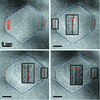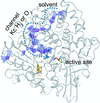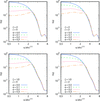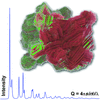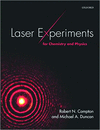issue contents
October 2016 issue

Cover illustration: Inverse pole figure color distributions for selected point-group symmetries. Courtesy of Nolze & Hielscher [J. Appl. Cryst. (2016), 49, 1786–1802].
research papers
This manuscript describes the novel neutron powder diffractometer PEARL at Delft University of Technology and shows the first experimental results.
The lattice tilts and full strain tensor are measured in Ge micro-devices under uniaxial or biaxial stress using standard and rainbow-filtered Laue micro-diffraction. Maps with sub-micrometre resolution of the strain tensor components are in very good agreement with finite element simulations.
Open  access
access
 access
accessGuinier peak analysis (GPA), derived from the Guinier approximation, transforms the Guinier region of small-angle X-ray scattering data into a characteristic peak that verifies the existence of the Guinier region in the data. Deviation of the Guinier peak position in dimensionless GPA plots can be a useful addition to sample characterization and parameter validation protocols.
Open  access
access
 access
accessA new simultaneous measurement method combining small-angle neutron scattering and Fourier-transform infrared spectroscopy was applied to a study on a syndiotactic polystyrene cocrystal with polyethylene glycol dimethyl ether with a molecular weight of 500. It is suggested that the guest molecules in the crystalline region have an elongated structure along the thickness direction of the crystalline lamellae.
Open  access
access
 access
accessA new biological small-angle X-ray scattering beamline (BioSAXS, BL19U2) at the Shanghai Synchrotron Radiation Facility (SSRF) is dedicated exclusively to small-angle scattering experiments from biological macromolecules in solution. As part of the important facilities in the National Center for Protein Sciences Shanghai (NCPSS), this BioSAXS beamline is the first in China to serve the rapidly increasing biology communities.
Combinational studies of synchrotron X-rays and neutrons have been performed to determine the site occupancy, valence state and magnetic structure of M-type BaTiMnFe10O19.
The construction of an α-quartz spherical analyzer and its application to a high-resolution measurement of the Kα1,2 X-ray emission lines of Ni are presented.
A new position-duplication-number method of calculating planar density is proposed. The new method does not require any auxiliary illustration.
The shrinkage of voids in aluminium through in situ annealing is imaged in a transmission electron microscope. It is found that voids first shrink anisotropically from a non-equilibrium to an equilibrium shape and then shrink while maintaining their equilibrium shape until they collapse. It is also observed that shrinkage is quantized, taking place one atomic layer and one void facet at a time.
An accelerated algorithm is presented for locating k points closest to a probe point, with application to searching for lattices closest to a given experimental cell.
A novel cryogenic gas pressure cell has been designed for structural studies of enzymes requiring gaseous substrates. The proof of principle is demonstrated for test crystals. The pressure cell has been designed for the study of O2-sensitive proteins to reveal pores, channels and reactive centres, and thus to decipher O2 traffic in proteins.
In this paper the principles, design and applications of the new neutron grating interferometry (nGI) setup at the Heinz Maier-Leibnitz Zentrum are presented. The dark-field contrast modality of the setup allows one to obtain spatially resolved information about the microstructure of a sample. In this way, nGI closes the gap between neutron imaging and small-angle neutron scattering.
Open  access
access
 access
accessThe diffraction response of the PMN–PT relaxor piezoelectric 67% Pb(Mg1/3Nb2/3)O3–33% PbTiO3 has been recorded as a function of externally applied electric field. The DC field was applied using a specially designed sample cell for in situ single-crystal diffraction experiments. The coverage of a significantly large section of reciprocal space allowed precise phase analysis.
A new method for the quantitative phase analysis of multi-component polycrystalline materials using the X-ray powder diffraction technique is proposed. The method can derive weight fractions from single-measurement integrated intensity datasets for individual phases and their chemical compositions. No standard reference material, reference intensity ratio or crystal structural parameter is required.
This article reports a suitable refinement of atomic models with charges against cryo-electron microscopy (cryo-EM) maps using a new package, ScatCurve.
The authors present an algorithm to compute the elastic scattering signal from nonspherical particles at arbitrary concentration that scales bilinearly in particle number and angular resolution of the scattering distribution.
An advanced three-dimensional mapping approach to reflection high-energy electron diffraction (RHEED) is discussed in detail and applied to study epitaxially grown magnetically ordered Co/MnF2/CaF2/Si(001) heterostructures.
Download citation


Download citation


This work describes in detail the structure of nonsubstituted and Re-substituted lanthanum tungstates studied through neutron diffraction as a function of temperature between 1.5 and 1200 K. Thermogravimetry and electron probe micro-analysis techniques were employed in combination with neutron diffraction to locate Re atoms in the LaWO crystal structure.
Open  access
access
 access
accessA method to enhance the X-ray diffraction signal of a specific targeted crystalline phase within a sample is presented. This technique can be implemented in a handheld or in-line instrument format.
A theoretical study of phase transitions in ZrO2 is presented.
A system for rapid texture measurement has been developed on the time-of-flight diffractometer iMATERIA, beamline BL 20, at MLF/J-PARC, Japan. Quantitative texture measurement for steel has become possible within a few minutes.
Ni–Co–Mn–In alloys are promising functional materials owing to their excellent multiple magnetoresponsive properties, which are closely related to their microstructures. In this work, the morphological and crystallographic features of the 6M modulated martensite in the Ni45Co5Mn37In13 alloy were characterized by electron backscatter diffraction and high-resolution transmission electron microscopy to provide comprehensive crystallographic information for related studies on these alloys.
A new algorithm is developed for high-performance computing of accurate powder diffraction patterns using the Debye scattering equation. The software implementing this alogrithm runs on a cluster of CPair-PU/GPU multi-core processors and allows rapid simulation of atomistic models of materials composed of several million atoms.
Heat treatments in the (α + β) or β phase regime and subsequent cooling induce significant microstructural changes in Zr-Excel (Zr–3.5Sn–0.8Mo–0.8Nb) by generating nondiffusional complex martensitic products. In the current study it is shown how modern whole pattern diffraction line profile analysis can individually characterize the defect structure of the martensitic and non-martensitic components of heat-treated Zr-Excel samples.
An in-house-constructed SAXS/WAXS instrument dedicated to the study of a wide range of nanomaterials is described. The different parts of the instrument are described in detail, along with several calibration standards and examples from recent research.
Thermal expansion anisotropy as source for microstrain broadening of polycrystalline cementite, Fe3C
Temperature-dependent synchrotron X-ray diffraction and neutron diffraction data from cementite, Fe3C, powder consisting of polycrystalline powder particles reveal temperature-dependent microstrain broadening. The extent and anisotropy of this broadening can be related to the simultaneously measured anisotropic thermal expansion of the orthorhombic unit cell via a model for thermal-microstress-induced microstrain.
The motion of ferroelectric domain walls (DWs) in a ferroelectric Bi4Ti3O12 single crystal was observed in situ under electron-beam irradiation in a transmission electron microscope. The migration of Ps(a)-90° DWs and the growth/annihilation of new needle-like Ps(a)-90° domains in a 20 µm-thick crystal were observed in situ under an applied electric field on a optical microscope.
Detailed considerations of how to construct inclined-incidence hard X-ray resonators are presented.
Open  access
access
 access
accessA technique for the analysis of magnetic scattering has been developed, where small-angle neutron scattering and Bragg edge transmission measurements are performed simultaneously. This technique is shown to provide crystallographic information for ferrite crystallites and nanostructural information for precipitates in steel.
Spatially resolved X-ray scattering and spectroscopy measurements, to separately probe and map reactions of individual components and regions within an operating electrochemical device, are enabled by the development of a tubular in situ cell.
Results of the first in situ energy-resolved neutron imaging of NiO–YSZ (YSZ is yttria-stabilized zirconia) reduction under applied stress are presented. Neutron experiments were performed at the pulsed neutron source ISIS (UK) using a time-of-flight approach.
The grain morphology and the agglomeration process due to low-temperature annealing (473 K) have been studied in Fe layers with Pt overlayers. Grazing-incidence small-angle X-ray scattering data indicate that the nanoparticles or nanoclusters appear as bimodal distributions and remain largely unaffected by annealing time.
Self-assembled nanostructures of ferroelectric–ferromagnetic oxide interfaces are observed in multilayer structures via the grazing-incidence small-angle X-ray scattering technique. Driven by the combination of strain relaxation and diffusion/segregation processes, an interdiffused columnar structure is formed with magnetic consequences.
Open  access
access
 access
accessFormation of ion tracks on a rutile TiO2 (001) surface after exposure to swift heavy ions under grazing incidence is studied using atomic force microscopy, grazing-incidence small-angle X-ray scattering and in situ time-of-flight elastic recoil detection analysis.
Open  access
access
 access
accessThe shape and sorption behaviour of pores in mesoporous ordered silica films are determined from grazing-incidence small-angle X-ray scattering data.
The possibility of using resonant multi-beam diffraction to resolve the crystal symmetry of YBaCuFeO5 is demonstrated.
Download citation


Download citation


Neutron powder diffraction (NPD) data were used to study the evolution of the crystal structure of BaTi1−xSnxO3 (BTS) induced by variations in the Ti/Sn ratio and temperature. The results obtained from NPD data are somewhat different from those previously determined from X-ray diffraction data, because NPD allows for a more precise determination of the Ba—O bond distances, fractional atomic coordinates and displacement parameters.
The limitations of the popular decoupling approximation used for the analysis of small-angle scattering from dispersions of anisotropic particles are established for ellipsoids of revolution of aspect ratio 0.333–3 as a function of particle concentration. The results provide guidance for the analysis and interpretation of small-angle scattering from colloidal, nanoparticle and protein solutions and suspensions.
Fast algorithms for calculating diffraction patterns from stacking-faulted materials have resulted in real speed gains of the order of 10 000 and more, allowing rapid structural and microstructural analysis of complex systems. These processes have been implemented in the computer program TOPAS Version 6.
A free web page under the name MAGNDATA, which provides detailed quantitative information on more than 400 published magnetic structures, has been developed. This first article is devoted to explaining the information and analysis tools available there for a set of more than 360 commensurate magnetic structures.
Transmission electron microscopy, atom probe tomography and small-angle neutron scattering are used to investigate precipitate formation in high Cu and S direct strip cast steels. S is found to be retained in solid solution in the as-cast condition and the composition of the Cu precipitates is found to depend on the initial alloy composition.
In electron backscatter diffraction maps, orientations needs to be colorized such that similar orientations are associated with similar colors and different orientations are associated with different colors. This paper provided correct color keys for almost all point groups.
short communications
Anomalous small-angle scattering measurements at the K absorption edge of Al for alumina powder and Al–Zn alloy foil have been demonstrated using a CCD detector. The change in the scattering intensity agreed with the expected contrast.
The band-flipping algorithm for structure solution with neutron data has been modified to account for the possible differing size of positive and negative neutron scattering lengths in a sample. Together with the band modification of low-density elimination it has been implemented in TOPAS and tested with both powder and Laue single-crystal time-of-flight neutron diffraction data.
An anisotropic deformation in silicon and germanium crystals effectively used for experiments is the quasi-mosaic curvature, which involves the curvature of crystallographic planes that would be flat in the case of an isotropic medium. Here, the curvature of {110} planes in a silicon crystal was obtained through the quasi-mosaic effect in the symmetric configuration and it was experimentally verified at the European Synchrotron Radiation Facility in Grenoble, France.
K-map scanning offers the possibility of characterizing intragranular strains and average dislocation density in single grains of plastically deformed polycrystals.
computer programs
SPICA provides fully interactive operations for stereographic analysis and beyond. It also includes various modules for essential crystallographic calculations.
Open  access
access
 access
accessThe US-SOMO HPLC-SAXS (high-performance liquid chromatography coupled with small-angle X-ray scattering) module is an advanced tool for the comprehensive analysis of SEC-SAXS (size-exclusion chromatography coupled with SAXS) data. It includes baseline and band-broadening correction routines, and Gaussian decomposition of overlapping skewed peaks into pure components.
An open-source Python library, PyNX.ptycho, is presented for the reconstruction of ptychographic data, optionally using OpenCL for high-performance computing. The article includes examples of analysis for both simulated and experimental data.
The new ISOSUBGROUP tool generates the isotropy subgroups of crystallographic space groups arising from arbitrary superpositions of irreducible representations, including magnetic and/or incommensurate cases, without reference to a parent structure.
crystallographers
Free 

book reviews
Free 



 journal menu
journal menu


















